This Kansas City-style smoked pulled pork has a deeply flavorful bark, a smoky flavor all the way through, and is so tender and juicy that it will shred with just your hands. The best part? It’s low maintenance and besides watching your smoker, you can set it and forget it until it’s done!
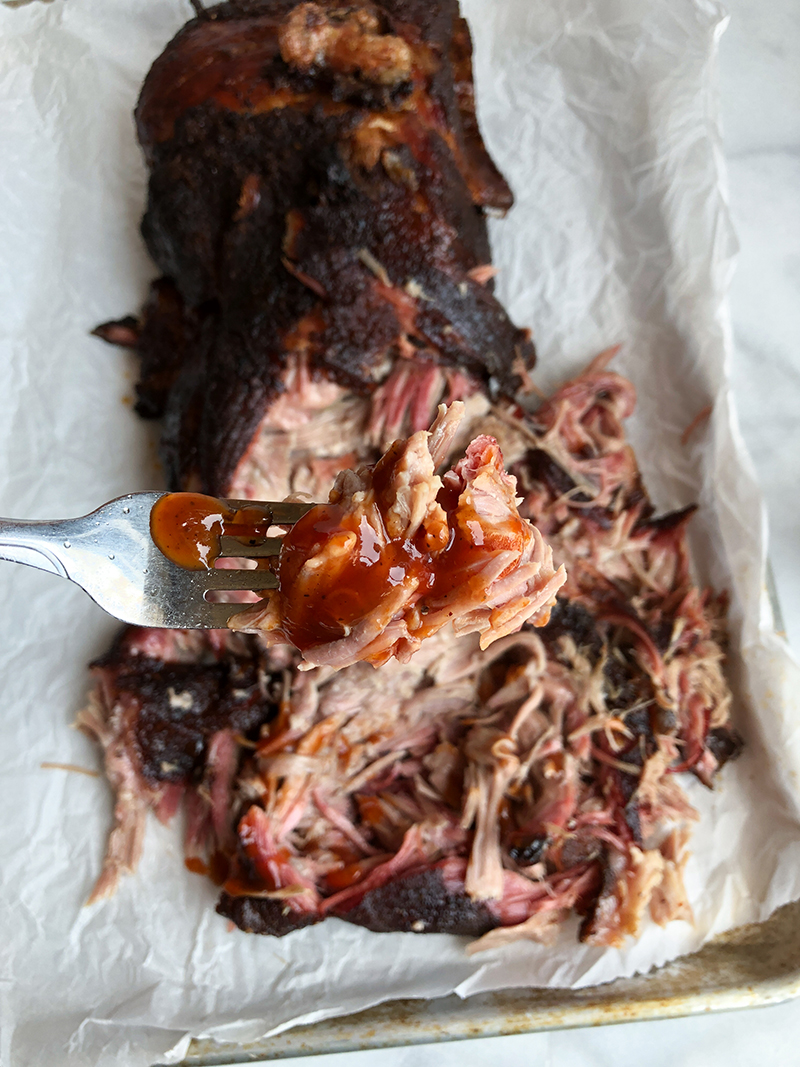
Alright everyone, let’s talk smoked pulled pork! When you first buy a smoker it’s the first thing everyone recommends you make (because it’s a cheap cut of meat and it’s pretty hard to screw up), but honestly it’s pretty intimidating at first and most people (hi, me included) messed it up at least a little the first time.
It can be hard to find reliable information with cooking styles like barbecue that are steeped in tradition and old wive’s tales – everyone you talk to will give you different advice and everyone is adamant that their way is the only way. Then to make it worse, they tell you things like “smoke it until it’s done” (not HELPFUL!). So when you finally do find exact instructions somewhere, it’s all so overwhelming that you’re temped to just throw in the towel before you even start. BUT smoking meat is NOT hard if you have the right information to do it, and luckily for you, I’ve sifted through thousands (okay, hundreds [alright, fine, tens]) of recipes, essays, and manifestos about smoking pork and this blog post is what I’ve learned and what I’ve been able to put to use.
If you want perfect succulent pork, but you just don’t know where to start – start here. I will cover everything I can think of to help you on your way to barbecue nirvana.
I have a Traeger, but no matter what you have, the basic cooking instructions and recipe will be the same for any smoker. You’ll just need to follow the manufacturer’s instructions for preparing your wood and starting up your smoker. The amount of “babysitting” you’ll need to do during cooking will vary greatly with the type of smoker you own. Traegers are very set-it-and-forget-it, an old school offset smoker isn’t, so use your best judgement.
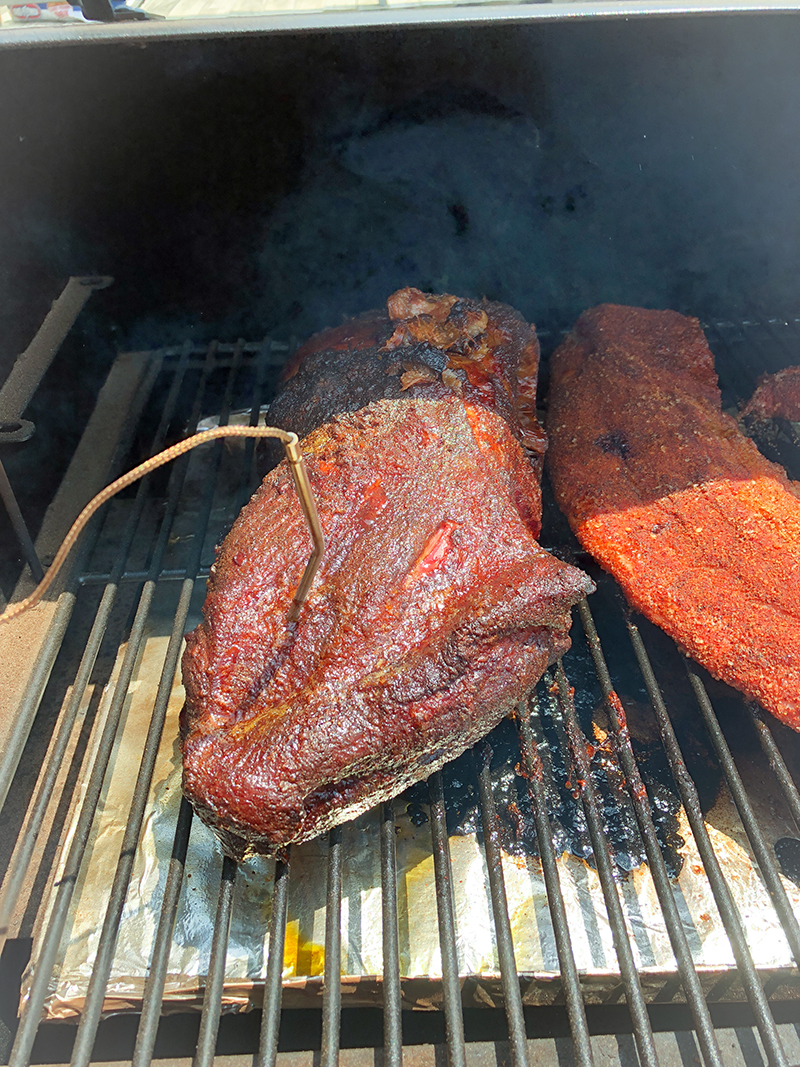
Smoking Temperature
Barbecue diehards will tell you to smoke at 225 degrees F or not to bother. Here’s the thing, that takes 100,000 years and depending on your smoker’s ability to hold heat and accurately measure temperature that could be way too low if you’re planning on eating the food sometime this week. You can smoke meat low and slow at any temperature below 275 degrees F and get the same results. I promise. I’ve tried it. Also, if you don’t believe me, then let me leave you with this: Aaron Franklin of renowned Franklin Barbecue in Austin, TX smokes all of his meat at 275 degrees F and recommends that you do, too, in his book.
Personally, I like to smoke pork shoulder at 250 degrees F because it significantly cuts down the cook time from the traditional 225 degrees F, but it’s still easy to manage and not a big deal if you forget to check the temperature for awhile. Whereas at 275FF, my pork finished SEVERAL HOURS before I planned for it to be done, and it’s a little harder to manage because you have to monitor it more aggressively.
I recommend you start with 250F, especially if you’re new to smoking meat and you haven’t quite figured your smoker out yet. It’s a good middle ground temperature which will deliver good results.
You might be tempted to turn the temp way up, which of course will get your pork “done” in record time, but meat only turns into barbecue at low and slow temperatures, so don’t do this because it won’t give you the results you want!
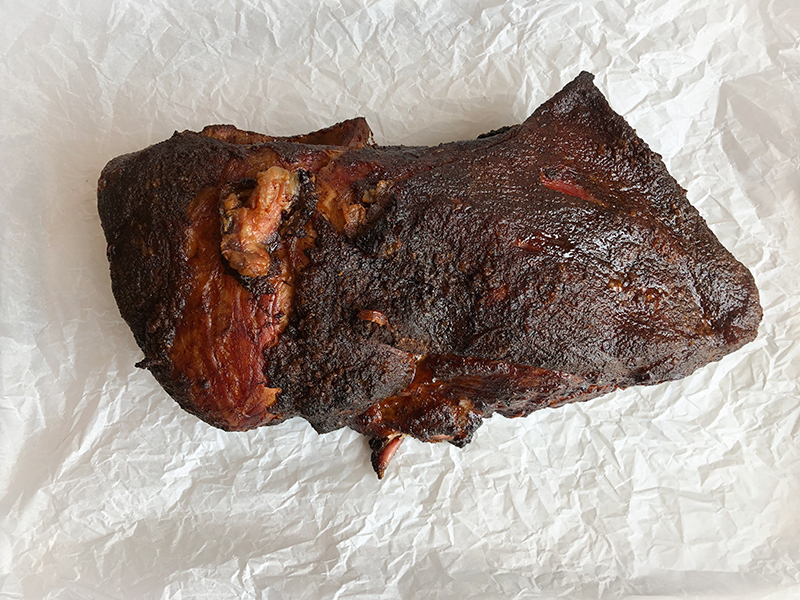
Internal Temperature and “The Stall”
Every serious cook will preach the importance of internal temperatures when cooking meat. It’s not only important for food safety, but they’re the only truly reliable indicator of when meat is done but not overcooked. (If you struggle with steaks and chicken breasts, get an instant read thermometer and use it!)
The recommended temperature for pork to be safe/done is 145F, but with barbecue you don’t just want the meat to be cooked, you want the fat and collagen to render out so it’s fall-apart tender and juicy which means the internal temp needs to be MUCH higher. The “perfect” temperature for smoked pulled pork is 203F. I know that sounds counter-intuitive to someone who is used to cooking things like pork chops to 145F, but if you pull that pork shoulder off at 145F it’ll be so tough that it won’t even pull apart with hulk-level strength.
I recommend you get a probe thermometer that you can stick in the meat when you start cooking with a cable that hooks up to an electronic gauge outside of the smoker so that you can watch your pork’s temperature without opening and closing the lid and letting your heat out. But any instant read thermometer will work just fine!
Old school pitmasters will tell you to test the meat’s doneness by seeing how easily you can pull the bone out or trying to shred it to see if it’s done, but the easiest and most reliable way is to just monitor the temperature.
HOWEVER, there’s a phenomena known as The Stall (dun, dun, duunnn) that is unique to meat cooked low and slow. You’ll see the temperature slowly rising at first, and then when you get to about 165F it will just stop moving (or it might even start dropping! The HORROR!) and it’ll seem like something is wrong. DON’T PANIC.
Listen, I was told about the stall when I bought my smoker and I didn’t believe it. It didn’t make any logical sense to me why it would happen. And when it did happen I freaked out thinking I was doing something wrong and messed with the pork and tried wrapping it in foil (more on that later) and all of this other stuff because it just didn’t make sense.
But actually, it’s science and it does happen. It’s because of evaporative cooling. At this point, the meat is losing moisture at the same rate or faster than it’s gaining heat. Basically, the meat is sweating. As the moisture that’s being pushed out reaches the surface of the meat, it evaporates which causes the temperature to cool down. Once every single last drop of moisture is gone, the temperature will start rising again and you’ll be on your way to perfectly smoked pulled pork.
Can you speed up the stall? Yeesss, but I don’t think it’s worth it. First of all, we’re already smoking at 250 degrees F, which will get you through it faster than if you were smoking at 225F. The most common way to speed up the stall is with what’s called “the Texas crutch”, which means taking the meat off when it hits the stall, wrapping it tightly in foil and then putting it back on. But when you wrap the meat in foil you’re essentially just letting it braise in it’s own juices instead of cook in the smoke, which means you’re taking it from a dry environment to a wet environment and that’s not going to do your bark any favors. Not to mention that it’s just a waste of wood because no more smoke is going to get to your meat. IF YOU MUST, don’t use foil, use pink butcher paper to help retain some of the bark. But please don’t do it at all. Just let your meat do it’s thing. You don’t need to wrap it, and by the time you open the smoker, take the meat out, wrap it up, and then open the smoker AGAIN to put the meat back on, the temperatures will have dropped so much that you’ll be setting yourself behind anyway. It truly doesn’t help that much anyway.
Just remember, it’s done when it’s done. It takes about 13 hours for a 7-9 lb pork shoulder, but so many things can affect this (weight of the meat, temperature of the meat when you put it on, temperature outside, etc.) you can’t speed it up and every smoker will give you a different result. Just track the temperature and be patient!
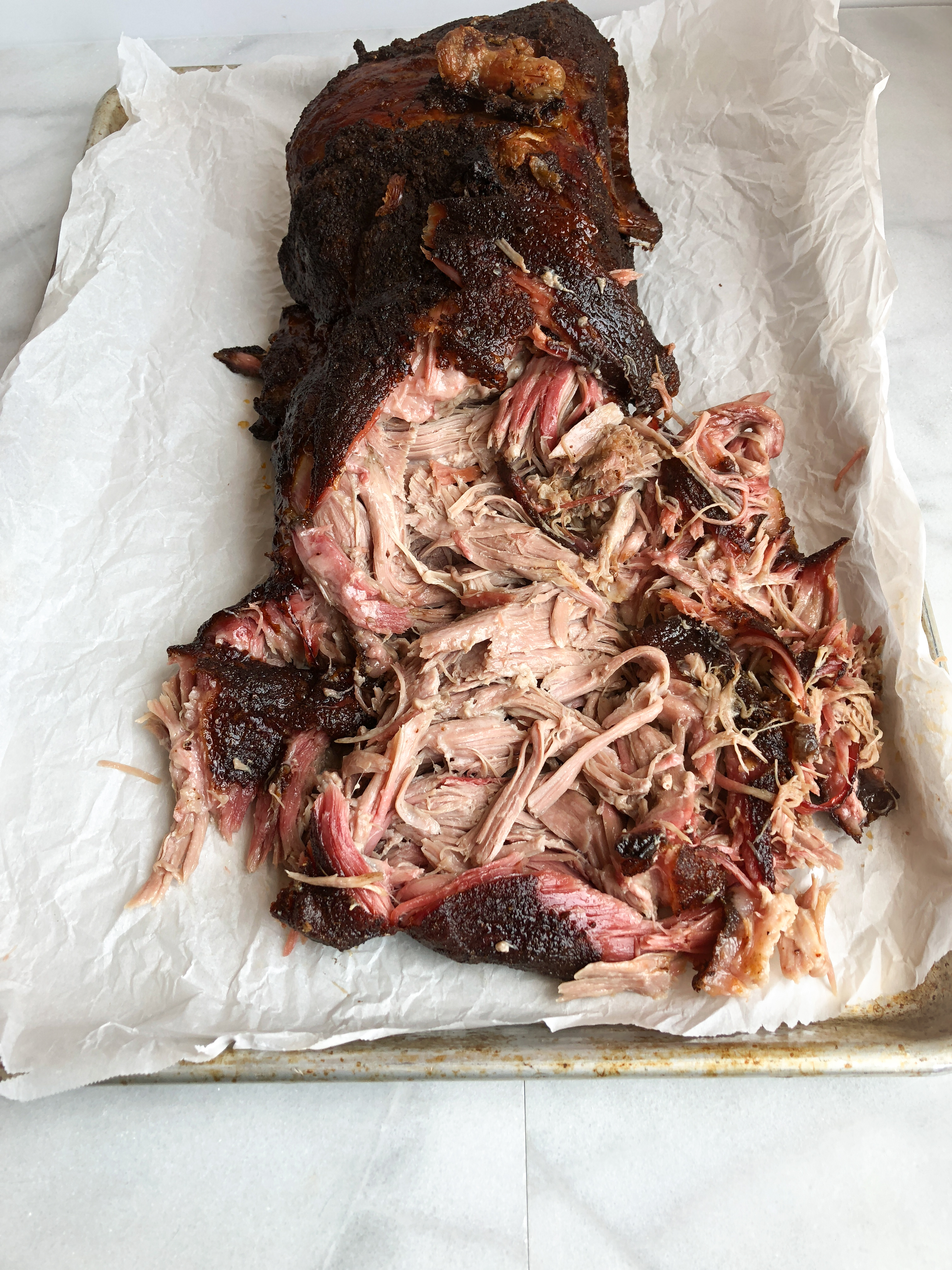
Ingredients, Injecting, and Basting
My favorite barbecue rub is a Kansas City style rub – sweet, a little spicy, and with garlic and onion powder. I think it’s got the deepest flavor, but it’s all about personal preference. You can use a different rub, and the instructions for cooking will still be identical! I make my own rubs because most pre-made rubs aren’t gluten free, but you can use a pre-made one too (although, these usually have MSG and other stuff you don’t need in them). It does take a large quantity of spices to make a rub, and it always looks like it’s way too much, but it really absorbs into the meat, so I assure you it’ll be the right amount!
Some people will inject their meat with a marinade (but this isn’t competition barbecue so I don’t), or baste it during the cooking (I think this hurts the bark and is unnecessary), but you can experiment with both of those things if you like!
Some people also use what’s called a “slather” under their spice rub to help it stick (usually yellow mustard). I’ve done it with and without and honestly I didn’t notice much difference in the end, so I go without because there’s less clean-up.
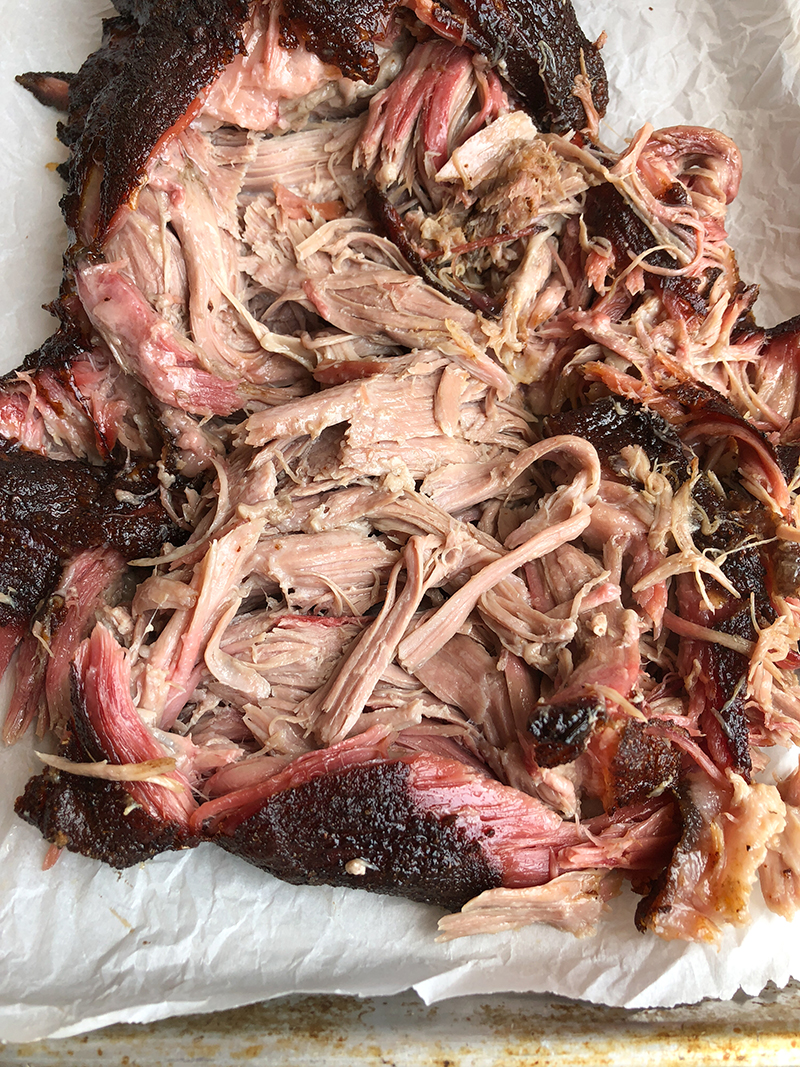
Lastly, I just want to talk for one second about the smoke ring. That’s the pinkish-red color right under the bark of the meat. Some people will tell you that it indicates how far the smoke penetrated the meat, however, that’s not true. It shows how far the smoke penetrated the meat before the meat hit a certain internal temperature. Smoke is still flavoring your meat after that, there’s just no visual evidence. The colder your meat is to start, the bigger your smoke ring will be. But again, amazingly smoky meat can exist without a smoke ring, and in fact it’s not allowed to be used as a judging criteria for competition barbecue anymore.
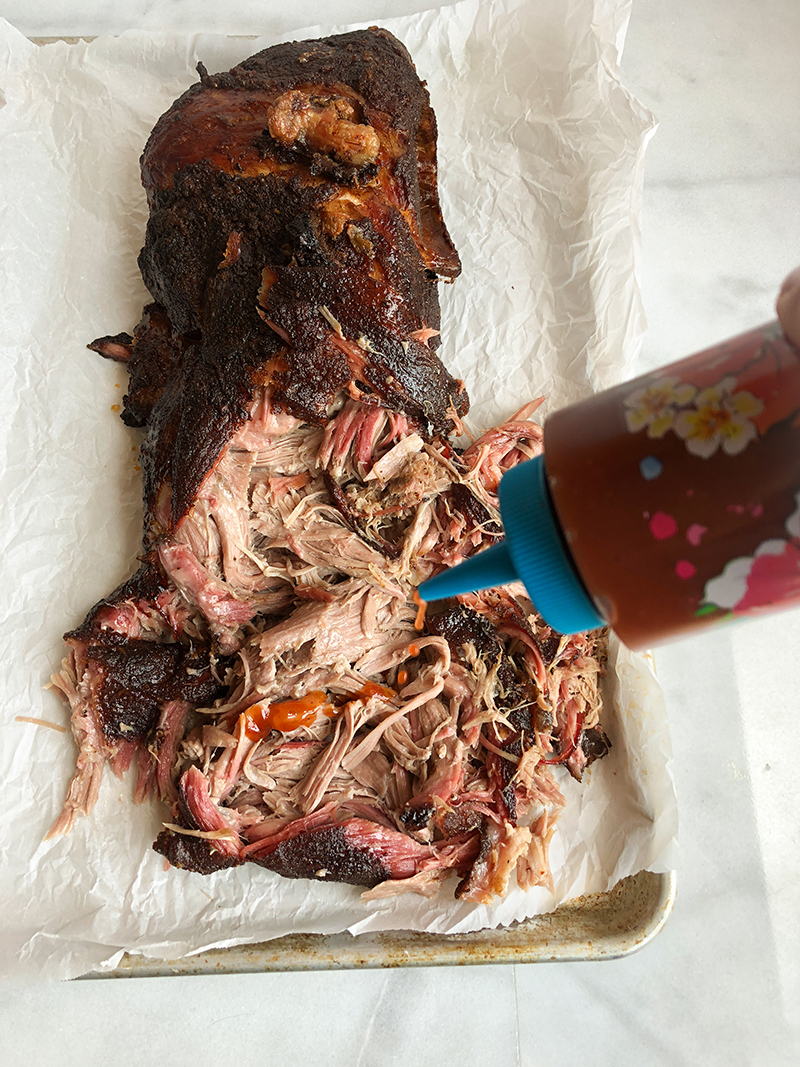
Alright! I think I’ve covered just about everything there is to cover! If you have any additional questions, let me know in the comments or drop me an email or DM me on Instagram and I will try to help!
Here’s the recipe:
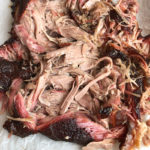
Smoked Kansas City-Style Pulled Pork
Smoked KC-Style Pulled Pork has a deep flavorful crust and perfectly smoky flavor, and it’s so tender that it falls apart with just your hands.
Ingredients
- 7-9 lb bone-in pork shoulder roast
- Enough pecan or hickory wood chunks/chips/pellets for 13 hours of burn time
Dry Rub
- 1/4 cup brown sugar
- 2 tablespoons kosher salt
- 1/2 tablespoon paprika
- 1/2 tablespoon chili powder
- 1 1/4 teaspoon black pepper
- 1 teaspoon onion powder
- 1 teaspoon garlic powder
- 1/2 teaspoon cumin
- 1/2 teaspoon dry mustard powder
- 1/2 teaspoon chipotle chili powder
Instructions
-
Prepare your smoker for 13 hours of smoke time and preheat to 250 degrees F.
-
In a small bowl, combine all of the dry rub ingredients. Pat the pork shoulder dry with paper towels, then apply the dry rub to all sides making sure to cover every inch and rub it in gently so it all sticks to the pork.
-
Place your pork into your pre-heated smoker (and if you have one, insert a probe thermometer into the thickest part of the meat away from the bone so you can monitor temperature without opening the smoker), and then don’t open the lid of the smoker again to check the internal temperature until at least 6 hours have passed, then you can start checking every two hours, until the 10 hour mark, then start checking hourly if you please.
-
Pork is done when an instant read or probe thermometer stuck into the thickest part of the meat away from the bone reads 203 degrees F. This takes about 13 hours. Meat should shred easily with your hands or with two forks. (For explanations about the internal temperature and the dreaded “stall” and everything else to get you started, please read the main post.)
Recipe Notes
You can prepare the pork for smoking ahead of time (and I recommend it because you will likely need to get up very early to put the pork on) by following the instructions through the application of the spice rub and then covering with plastic wrap and refrigerating until ready to smoke.
To reheat leftovers, add a couple of tablespoons of apple cider vinegar, water, chicken broth, or apple juice to the pork and reheat in a low oven or in the microwave.

Leave a Reply